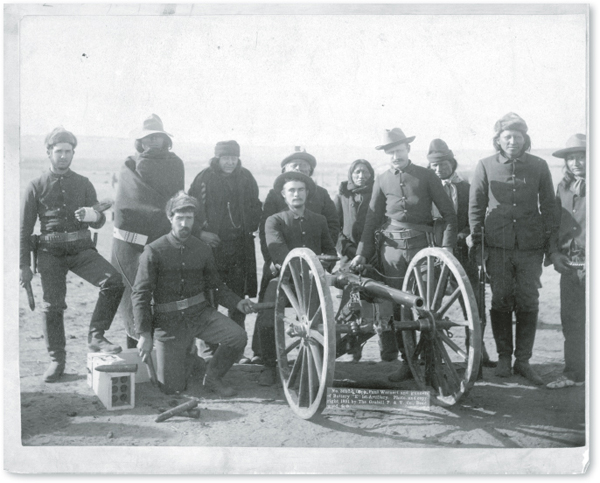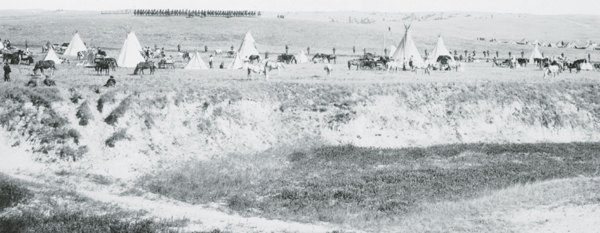
We tried to run, but they shot us like we were buffalo.
—LOUISE WEASEL BEAR OF THE MINNECONJOU SIOUX

HAD IT NOT BEEN FOR THE GHOST Dance religion, the Sioux in their grief and anger over the assassination of Sitting Bull might have risen up against the guns of the soldiers. But hundreds of now leaderless Hunkpapas fled Standing Rock, seeking refuge in one of the Ghost Dance camps or with the last of the great chiefs, Red Cloud, at Pine Ridge. On the 17th of the Moon when the Deer Shed Their Horns (December), about 100 of these fleeing Hunkpapas reached Big Foot’s Minneconjou camp near Cherry Creek. That same day the War Department issued orders for the arrest and imprisonment of Big Foot. He was on the list of “fomenters of disturbances.”
As soon as Big Foot learned that Sitting Bull had been killed, he started his people toward Pine Ridge, hoping Red Cloud could protect them from the soldiers. En route, he fell ill with pneumonia. When his lungs began bleeding, he had to travel in a wagon. On December 28, as they neared Porcupine Creek, the Minneconjous sighted four troops of cavalry approaching. Big Foot immediately ordered a white flag raised over his wagon. That afternoon he greeted Major Samuel Whitside, Seventh U.S. Cavalry. Big Foot’s blankets were stained with blood, and as he talked in a hoarse whisper with Whitside, red drops fell from his nose and froze in the bitter cold.
Whitside told Big Foot that he had orders to take him to a cavalry camp on Wounded Knee Creek. The Minneconjou chief replied that he was going in that direction. He was taking his people to Pine Ridge for safety.
The major glanced at the ailing chief and then gave an order for his army ambulance to be brought forward. The ambulance would be warmer and would give Big Foot an easier ride than the jolting wagon. After that was done, the combined column renewed its trek.
Twilight was falling when the column reached Chankpe Opi Wakpala, the creek called Wounded Knee. The wintry dusk and the tiny crystals of ice dancing in the dying light added a supernatural quality to the somber landscape.
At the cavalry tent camp on Wounded Knee Creek, the Indians were carefully counted. There were 120 men and 230 women and children. Because of the gathering darkness, Major Whitside decided to wait until morning before disarming his prisoners. He assigned them a camping area immediately to the south of the military camp and issued them rations. As there was a shortage of tepee covers, he gave them several tents. Whitside ordered a stove placed in Big Foot’s tent and sent a regimental surgeon to care for the sick chief. To make certain that none of his prisoners escaped, the major stationed two troops of cavalry around the Sioux tepees and then posted his two Hotchkiss guns on top of a rise overlooking the camp. The barrels of these guns, which could hurl explosive charges for more than two miles, were positioned to rake the length of the Indian lodges.
Later in the darkness of that December night, the remainder of the Seventh Regiment marched in from the east and quietly set up camp north of Major Whitside’s troops. Colonel James W. Forsyth, the man who had been given command of Custer’s former regiment, now took charge of operations.

An 1891 John C. H. Grabill photograph of a unit of troops around a Hotchkiss gun. The Hotchkiss gun was a light, easy-to-use cannon favored by troops at the end of the 19th century. [LOC, DIG-ppmsc-02552]

This 1913 photograph shows a Sioux camp near the site of the Wounded Knee Massacre. A line of cavalry troops is in the background. [LOC, USZ62-133722]
After placing two more Hotchkiss guns on the slope beside the others, Forsyth and his officers settled down for the evening with a keg of whiskey to celebrate the capture of Big Foot.
“The following morning there was a bugle call,” said Wasumaza, one of Big Foot’s warriors. “Then I saw the soldiers mounting their horses and surrounding us. It was announced that all men should come to the center for a talk and that after the talk they were to move on to Pine Ridge agency. Big Foot was brought out of his tepee and sat in front of his tent, and the older men were gathered around him and sitting right near him in the center.”
After issuing hardtack biscuits for breakfast rations, Colonel Forsyth informed the Indians that they were now to be disarmed. “They called for guns and arms,” White Lance, a member of Big Foot’s band, later said, “so all of us gave the guns and they were stacked up in the center.” The soldier chiefs were not satisfied with the number of weapons surrendered and sent details of troops to search the tepees. “They would go right into the tents and come out with bundles and tear them open,” Dog Chief, another member, said. “They brought our axes, knives, and tent stakes and piled them near the guns.”
Still not satisfied, the soldier chiefs ordered the warriors to remove their blankets and submit to searches for weapons. The Indians’ faces showed their anger, but only the medicine man, Yellow Bird, made any real protest. He danced a few Ghost Dance steps, and chanted one of the holy songs, assuring the warriors that the soldiers’ bullets could not penetrate their sacred garments.
Troopers found only two rifles, one of them a new Winchester belonging to a young Minneconjou named Black Coyote. Black Coyote raised the Winchester above his head, shouting that he paid much money for the rifle and that it belonged to him. Some years afterward, Wasumaza, who had changed his name to Dewey Beard, recalled that Black Coyote was deaf.
If they had left him alone, he was going to put his gun down where he should. They grabbed him and spinned him in the east direction. He was still unconcerned even then. He hadn’t his gun pointed at anyone. His intention was to put that gun down. They came on and grabbed the gun that he was going to put down. Right after they spun him around there was the report of a gun, was quite loud. I couldn’t say that anybody was shot, but following that was a crash.

This map shows the location of Big Foot’s camp and the surrounding cavalry positions just before the Wounded Knee Massacre occurred.
At the sound of the gunshot, the soldiers began firing their weapons. The sound of rifles was deafening, filling the air with powder smoke. Among the dying who lay sprawled on the frozen ground was Big Foot. Then there was a brief lull in the rattle of arms, with small groups of Indians and soldiers grappling at close quarters, using knives, clubs, and pistols. As few of the Indians had arms, they soon had to flee. Then the big Hotchkiss guns on the hill opened up on them, raking the Indian camp, shredding the tepees with flying shrapnel, killing men, women, and children.

In 1891 Harper’s Weekly published this illustration by artist Frederick Remington of the beginning of the Wounded Knee Massacre. Like many other illustrations of the army’s battles with the Indians, this one is historically inaccurate. [LOC, USZ62-89867]
When the madness ended, Big Foot and more than half of his people were dead or seriously wounded. One estimate placed the final total of dead at nearly 300 of the original 350 men, women, and children. Twenty-five soldiers were dead and 39 wounded, most of them struck by their own bullets or shrapnel.
After the wounded cavalrymen started for the agency at Pine Ridge, a detail of soldiers went over the Wounded Knee site, gathering up Indians who were still alive and loading them into wagons. Since a blizzard was approaching, the dead Indians were left where they had fallen. After the blizzard, when a burial party returned to Wounded Knee, they found the bodies, including Big Foot’s, frozen into grotesque shapes.
The wagonloads of wounded Sioux, four men and 47 women and children, reached Pine Ridge after dark. Because the barracks were filled with soldiers, they were left lying in the open wagons in the bitter cold while an inept army officer searched for shelter. Finally the Episcopal mission was opened, the benches taken out, and hay scattered over the rough flooring.

Orlando Scott Goff photographed the ravine where the Wounded Knee Massacre occurred about three weeks after the event. Some of the bodies can be seen in the background. [LOC, USC62-42550]
It was the fourth day after Christmas 1890. When the first torn and bleeding bodies were carried into the candlelit church, those who were conscious saw Christmas greenery hanging from the open rafters. Above the pulpit was strung a banner: PEACE ON EARTH, GOOD WILL TO MEN.

Another photograph by Orlando Scott Goff of the aftermath of the massacre at Wounded Knee. About three weeks after it happened, a burial party arrived to gather those who had been killed. In the foreground are some of the bodies, covered with blankets. [LOC, DIG-ppmsca-15849]
